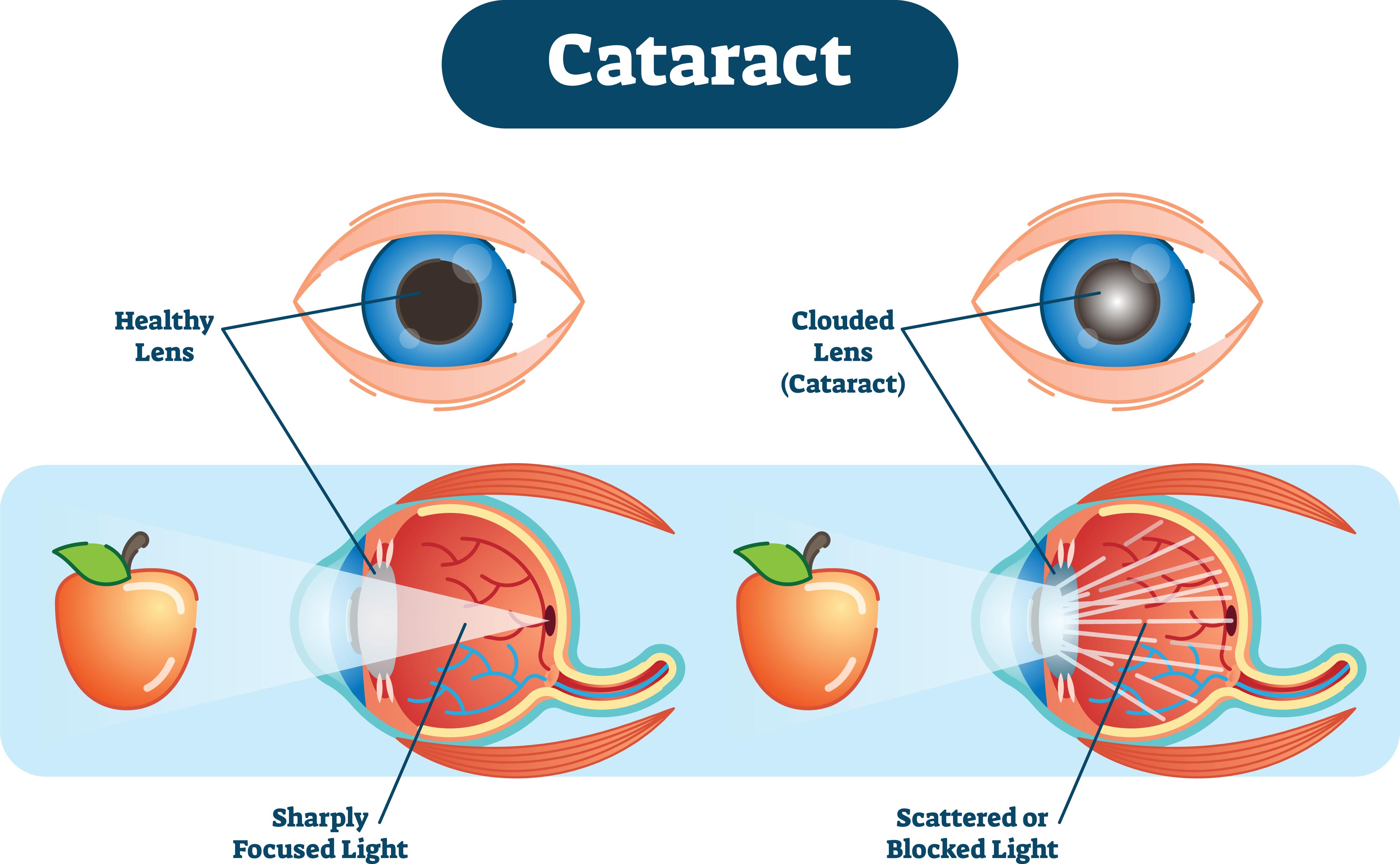Everything you need to know about cataracts

A cataract is a clouding of the eye’s lens. This is an area that is normally clear. As this clouding happens, it keeps light rays from passing through the lens and focusing on the retina. The retina is a tissue lining that is sensitive to light. It is located in the back of the eye. This cloudiness happens when some of the protein that makes up the lens starts to change its structure. It then gets in the way of your eyesight.
In its early stages, a cataract may not cause a problem. The cloudiness may affect only a small part of the lens. But the cataract may grow larger over time. It may affect more of the lens. This can make it harder for you to see. If less light reaches the retina, it becomes even harder to see. Your vision may become dull and blurry. Cataracts can’t spread from one eye to another. But many people do get cataracts in both eyes.
There are many types of cataracts:
- Age-related cataracts. Most cataracts are related to aging.
- Congenital cataracts. Some babies are born with cataracts. Some children develop them in childhood, often in both eyes. Some congenital cataracts don’t affect eyesight. But others do and must be removed.
- Secondary cataracts. Secondary cataracts often happen because of another disease in the body (such as diabetes). Secondary cataracts have also been linked to steroid use.
- Traumatic cataracts. An injury to one or both eyes may cause you to have a traumatic cataract. This can happen either right after the accident or several years later.
What causes cataracts?
Experts don’t know for sure what causes cataracts. But hey think there could be several possible causes, including:
- Smoking
- Alcohol
- Diabetes
- Nutritional deficiency
- Unprotected exposure to UV radiation sunlight
- Steroid use
- Certain diuretic use
- Certain tranquilizers
For many of the possible causes, more research is needed to set apart the effect of the disease from the effect of the medicines.
Who is at risk for cataracts?
Possible risk factors include:
- Age. Age is the greatest risk factor for cataracts. Age-related cataracts may start to develop between ages 40 and 50.
- Where you live. Recent studies have shown that people who live in high altitudes are more at risk of having cataracts.
- Too much sun exposure. People who spend more time in the sun, especially without eye protection, may have cataracts sooner than others.
What are the symptoms of cataracts?
Symptoms may be a bit different for each person. Symptoms may include:
- Cloudy or blurry vision
- Lights cause a glare or a halo
- Poor night vision
- Multiple (double) vision
- Colors seem faded
- Increased nearsightedness, increasing the need to change eyeglass prescriptions
Often in the disease’s early stages, you may not notice any changes in your vision. Cataracts tend to grow slowly. So your eyesight will get worse slowly. Certain cataracts can also cause your close-up vision to get better for a short time. But your eyesight is likely to get worse as the cataract grows. The symptoms of cataracts may look like other eye conditions. Talk with a healthcare provider for a diagnosis.
How are cataracts treated?
Treatment will depend on your symptoms, age, and general health. It will also depend on how severe the condition is.
The symptoms of cataracts sometimes look like other conditions or health problems. Always see your healthcare provider for a diagnosis.
In its early stages, vision loss caused by a cataract may be helped by using different eyeglasses, a magnifying glass, or stronger lighting. When these are no longer helpful, surgery is the only effective treatment. A cataract only needs to be removed when vision loss gets in the way of your daily activities. This includes driving, reading, or watching TV. You and your eye care provider can make that decision together.
Cataract surgery is one of the most common surgeries. It is also one of the safest and most effective. Surgery includes replacing the cloudy lens with a new lens. If you have cataracts in both eyes, they are often not taken out at the same time. Your eye care provider will need to do the surgery on each eye separately.
Cataracts are often taken out in one of 2 ways:
- Small incision cataract surgery (phacoemulsification). This is the most common type of cataract removal surgery. The eye care provider makes a small cut (incision) on the edge of the cornea. The cornea is a clear, dome-shaped surface that covers the front of the eye. A tiny probe gives off ultrasound waves to break up the cloudy center of the lens. The cataract is then removed by suction through the same incision.
- Extracapsular surgery. During this surgery, a longer incision is made on the edge of the cornea to remove the hard center of the lens in one piece. The rest of the lens is then taken out by suction.
The removed lens is replaced by an intraocular lens (IOL) in most cataract surgeries. An IOL is a clear, artificial lens that does not need care. It becomes part of the eye. With an IOL, a person often has better eyesight. That’s because light will be able to pass to the retina. The person does not see or feel the new lens.
What are possible complications of cataracts?
Over time, cataracts will harm your vision. Cataract surgery can bring back your vision. But a possible complication of cataract surgery is an after-cataract. This happens when part of the natural lens that is purposely not taken out during cataract surgery becomes cloudy and blurs your eyesight. Unlike a cataract, an after-cataract can be treated with a method called YAG laser capsulotomy. The healthcare provider uses a laser beam to make a tiny hole in the cloudy membrane behind the lens to let the light pass through. After-cataracts may occur months, or even years, after cataract surgery.
